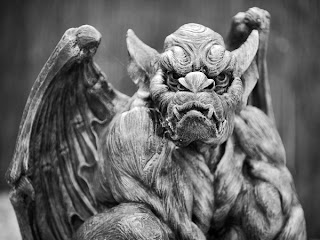There are places in Nla-Ogupta--that ancient, decadent, Venusian Venice--where Terrans do not go. The Street of Blue Vines was one of those. The buildings along it crowded close, as if trying to conceal some secret. The uncanny glow of bioluminescent lantern-jellies that cling to haphazard lines seem dimmer than elsewhere--as if they too were conspirators. It's said that in millennia past, when Egypt was young, the Street of Blue Vines was a place where cultists trafficked with inhuman gods. Old Venus-hands, deep in their cups, spin tales of cannibalism, and alien sexual rites. That's what the rumors say. No Terran knows, and if any polite Venusian knows, they don't speak of it to offworlders.
But on this night, a Terran does wind his way down the serpentine Street of Blue Vines. His stride is unhesitating--he hasn't come this way accidentally. He moves purposely to the darkened, leaning structure which bears no sign or legend, but nevertheless is known to the denizens of Nla-Ogupta's underworld as the House Tenebrous. He has come seeking this house, and the service it sells. He's come to buy a man's death.
The Street of Blue Vines gets its name from the eerie, electric indigo vines and foliage that entwine 'round its most infamous denizen, the House Tenebrous. The House only permits entrance at night--in fact, it may be that it can only be located at night.
A seated, robed figured, appearing as a short and portly man, his features completely hidden in a cowl, asks any visitor who he or she might wished kill, and why. The figure’s voice sounds distant, and tinny, and seems to emanate from all around. The man never moves, even in the slightest. Sometimes visitors get the impression that there are others in the room--the feeling of eyes upon them, or the hint of motion in the shadows of the audience chamber. Psychically sensitive individuals report “hearing” distant, unintelligible, whispers, and an unpleasant mental sensation not unlike smothering.
If the man chooses to accept the comission, the price is variable, and not always in money. If a goal can be discerned from House's representative's payment demands, it is that they seem to be aimed at reducing Terran influence on Venus.
Eventually, though a space of week or months may pass, all victims of the House Tenebrous are found dead somewhere in Nla-Ogupta (or in one case, on a ship having recently departed there) without any apparent signs of violence or physical injury. Victims always appear to have died in their sleep, though often their face and bodies are contorted as if in fear or pain.



















